旅游英语Unit Two
- 格式:ppt
- 大小:3.50 MB
- 文档页数:10

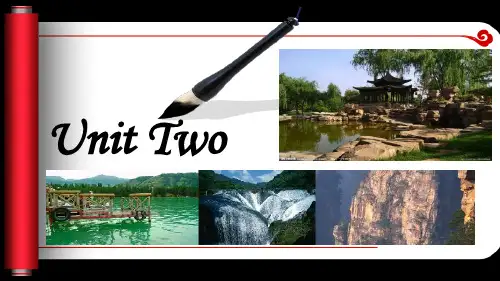

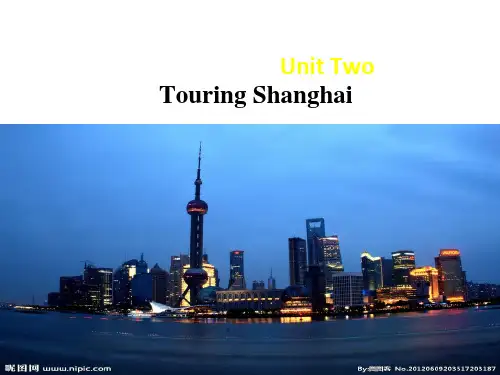

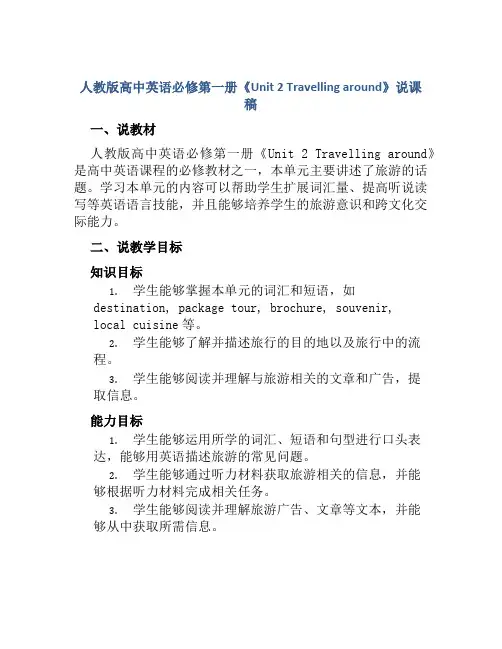
人教版高中英语必修第一册《Unit 2 Travelling around》说课稿一、说教材人教版高中英语必修第一册《Unit 2 Travelling around》是高中英语课程的必修教材之一,本单元主要讲述了旅游的话题。
学习本单元的内容可以帮助学生扩展词汇量、提高听说读写等英语语言技能,并且能够培养学生的旅游意识和跨文化交际能力。
二、说教学目标知识目标1.学生能够掌握本单元的词汇和短语,如destination, package tour, brochure, souvenir,local cuisine等。
2.学生能够了解并描述旅行的目的地以及旅行中的流程。
3.学生能够阅读并理解与旅游相关的文章和广告,提取信息。
能力目标1.学生能够运用所学的词汇、短语和句型进行口头表达,能够用英语描述旅游的常见问题。
2.学生能够通过听力材料获取旅游相关的信息,并能够根据听力材料完成相关任务。
3.学生能够阅读并理解旅游广告、文章等文本,并能够从中获取所需信息。
情感目标1.培养学生的旅游意识和跨文化交际能力,增强学生对不同国家和地区的兴趣和了解。
2.提高学生的自学能力和合作意识,培养学生独立学习和团队合作的能力。
三、说教学重难点教学重点1.旅游相关的词汇和短语的掌握及运用。
2.用英语描述旅行的目的地和旅行过程。
教学难点1.提高学生的听力技能,能够从听力材料中获取重要信息。
2.培养学生的阅读理解能力,能够从旅游广告、文章等文本中获取所需信息。
四、说教学内容及安排1. 词汇和短语的学习(课时1)1.1 听读课文中的生词通过听读课文中的生词,帮助学生掌握本单元所需的词汇和短语。
1.2 词汇和短语的分类学习将本单元所涉及的词汇和短语进行分类学习,如旅行方式(package tour),旅行目的地(destination),旅行准备(brochure),旅行购物(souvenir)等。
2. 口语表达技巧的训练(课时2-3)2.1 选择合适的语句结构进行描述通过训练,帮助学生选择合适的语句结构进行描述旅行的目的地和旅行过程,如使用There is/are…,I want to…等。
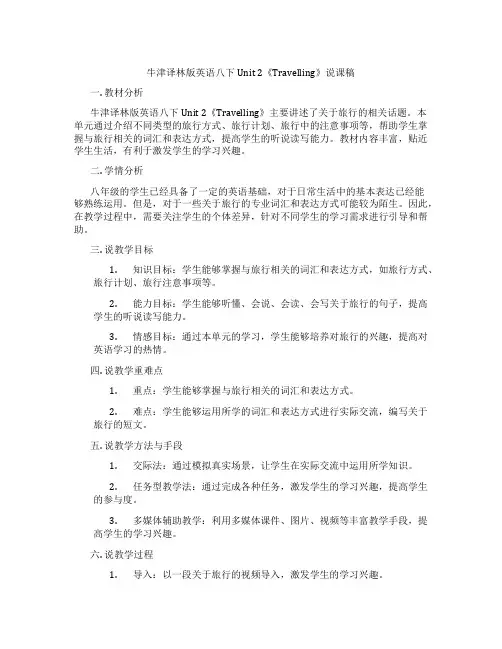
牛津译林版英语八下Unit 2《Travelling》说课稿一. 教材分析牛津译林版英语八下Unit 2《Travelling》主要讲述了关于旅行的相关话题。
本单元通过介绍不同类型的旅行方式、旅行计划、旅行中的注意事项等,帮助学生掌握与旅行相关的词汇和表达方式,提高学生的听说读写能力。
教材内容丰富,贴近学生生活,有利于激发学生的学习兴趣。
二. 学情分析八年级的学生已经具备了一定的英语基础,对于日常生活中的基本表达已经能够熟练运用。
但是,对于一些关于旅行的专业词汇和表达方式可能较为陌生。
因此,在教学过程中,需要关注学生的个体差异,针对不同学生的学习需求进行引导和帮助。
三. 说教学目标1.知识目标:学生能够掌握与旅行相关的词汇和表达方式,如旅行方式、旅行计划、旅行注意事项等。
2.能力目标:学生能够听懂、会说、会读、会写关于旅行的句子,提高学生的听说读写能力。
3.情感目标:通过本单元的学习,学生能够培养对旅行的兴趣,提高对英语学习的热情。
四. 说教学重难点1.重点:学生能够掌握与旅行相关的词汇和表达方式。
2.难点:学生能够运用所学的词汇和表达方式进行实际交流,编写关于旅行的短文。
五. 说教学方法与手段1.交际法:通过模拟真实场景,让学生在实际交流中运用所学知识。
2.任务型教学法:通过完成各种任务,激发学生的学习兴趣,提高学生的参与度。
3.多媒体辅助教学:利用多媒体课件、图片、视频等丰富教学手段,提高学生的学习兴趣。
六. 说教学过程1.导入:以一段关于旅行的视频导入,激发学生的学习兴趣。
2.新课呈现:通过展示图片、实物等,引入本节课的主题,引导学生学习相关词汇和表达方式。
3.课堂练习:设计不同类型的练习,让学生在实际交流中运用所学知识。
4.小组活动:学生分组进行讨论,分享各自的旅行经历,促进学生之间的交流。
5.课堂小结:对本节课所学内容进行总结,帮助学生巩固记忆。
6.课后作业:布置相关任务,让学生课后进行练习,巩固所学知识。
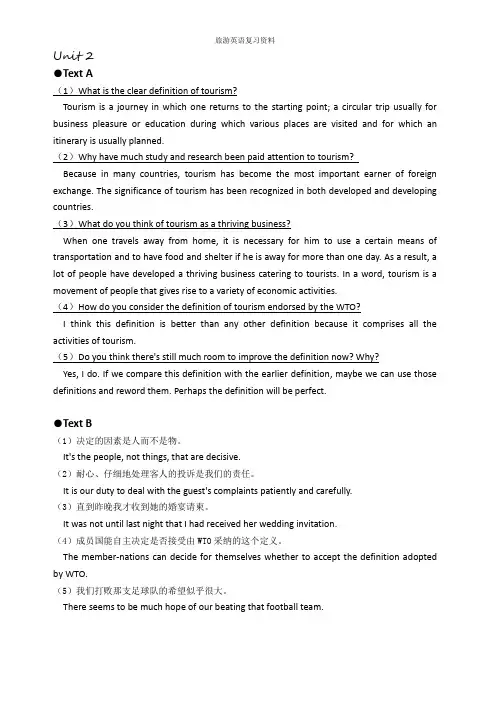
Unit 2●Text A(1)What is the clear definition of tourism?Tourism is a journey in which one returns to the starting point; a circular trip usually for business pleasure or education during which various places are visited and for which an itinerary is usually planned.(2)Why have much study and research been paid attention totourism?Because in many countries, tourism has become the most important earner of foreign exchange. The significance of tourism has been recognized in both developed and developing countries.(3)What do you think of tourism as a thriving business?When one travels away from home, it is necessary for him to use a certain means of transportation and to have food and shelter if he is away for more than one day. As a result, a lot of people have developed a thriving business catering to tourists. In a word, tourism is a movement of people that gives rise to a variety of economic activities.(4)How do you consider the definition of tourism endorsed by the WTO?I think this definition is better than any other definition because it comprises all the activities of tourism.(5)Do you think there's still much room to improve the definition now? Why?Yes, I do. If we compare this definition with the earlier definition, maybe we can use those definitions and reword them. Perhaps the definition will be perfect.●Text B(1)决定的因素是人而不是物。
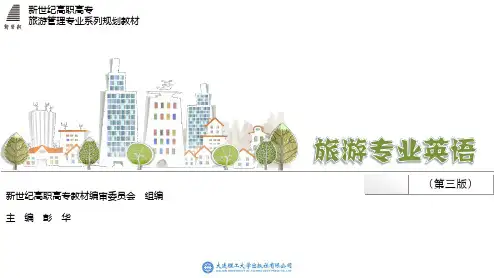
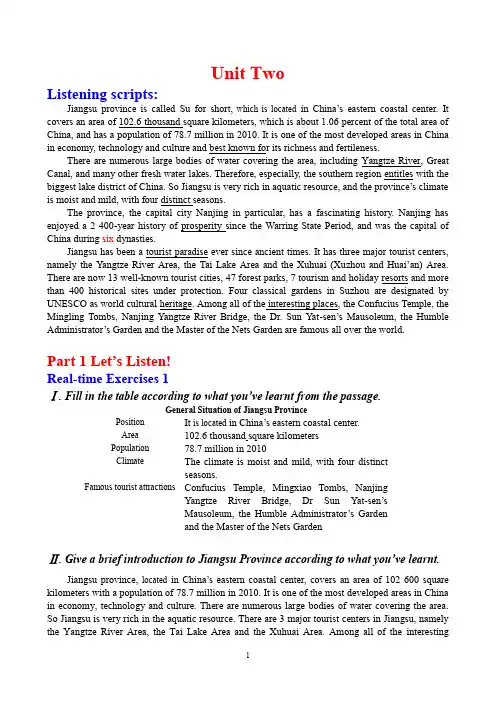
Unit TwoListening scripts:Jiangsu province is called Su for short,which is located in China’s eastern coastal center. It covers an area of 102.6 thousand square kilometers, which is about 1.06 percent of the total area of China, and has a population of 78.7 million in 2010. It is one of the most developed areas in China in economy, technology and culture and best known for its richness and fertileness.There are numerous large bodies of water covering the area, including Yangtze River, Great Canal, and many other fresh water lakes. Therefore, especially, the southern region entitles with the biggest lake district of China. So Jiangsu is very rich in aquatic resource, and the province’s climate is moist and mild, with four distinct seasons.The province, the capital city Nanjing in particular, has a fascinating history. Nanjing has enjoyed a 2 400-year history of prosperity since the Warring State Period, and was the capital of China during six dynasties.Jiangsu has been a tourist paradise ever since ancient times. It has three major tourist centers, namely the Yangtze River Area, the Tai Lake Area and the Xuhuai (Xuzhou and Huai’an) Area. There are now 13 well-known tourist cities, 47 forest parks, 7 tourism and holiday resorts and more than 400 historical sites under protection. Four classical gardens in Suzhou are designated by UNESCO as world cultural heritage. Among all of the interesting places, the Confucius Temple, the Mingling Tombs, Nanjing Yangtze River Bridge, the Dr. Sun Yat-sen’s Mausoleum, t he Humble Administrator’s Garden and the Master of the Nets Garden are famous all over the world.Part 1 Let’s Listen!Real-time Exercises 1Ⅰ. Fill in the table according to what you’ve learnt from the passage.General Situation of Jiangsu ProvincePosition It is located in China’s eastern coastal center.Area 102.6 thousand square kilometersPopulation 78.7 million in 2010Climate The climate is moist and mild, with four distinctseasons.Famous tourist attractions Confucius Temple, Mingxiao Tombs, NanjingYangtze River Bridge, Dr Sun Yat-sen’sMausoleum, the Humble Administrator’s Gardenand the Master of the Nets GardenⅡ. Give a brief introduction to Jiangsu Province according to what you’ve learnt.Jiangsu province, located in China’s easte rn coastal center, covers an area of 102 600 square kilometers with a population of 78.7 million in 2010. It is one of the most developed areas in China in economy, technology and culture. There are numerous large bodies of water covering the area. So Jiangsu is very rich in the aquatic resource. There are 3 major tourist centers in Jiangsu, namely the Yangtze River Area, the Tai Lake Area and the Xuhuai Area. Among all of the interestingplaces, Confucius Temple, Mingxiao Tombs, Nanjing Yangtze River Bridge, Dr Sun Yat-sens Mausoleum, The Humble Administrators Garden and the Master of the Nets Garden are welcome all over the world.Part 2 Let’s Learn!Real-time Exercises 2I. Decide whether the statements are true (T) or false (F) according to the passage.1. F2.F3.T4.F5.TII. Answer the following questions according to what you’ve learnt.Answers:1. On-the-way introduction refers to the introduction of the tourist sites during the way to the destination. It includes three kinds of introduction, namely the first time on-the-way introduction, the on-the-way introduction to tourist sites and the on-the-way introduction after the tour.2. A good introduction can not only let the tourists have a good understanding of the tourist sites, but also help the tour guide give a good impression on the tourists.3. Give a brief introduction of the local city including its location, population, climate, customs and culture. Introduce the station, sceneries, shopping malls, overpasses or architectures immediately. Inform some information of the check-in hotel including name, position, etc.4. The on-the-way introduction of the tourist sites may include the following points: Tell tourists the itinerary of the day; Introduce the tourist destination briefly; Provide information of the local customs and scenery on the way; Initiate entertainments to promote friendship between tourists.5. Summarize the sightseeing activities on suitable occasions when the tour is over and recommend additional insights to places of interests on the way home.6. A guide should give the tourists a dynamic on-the-way introduction and focus on the major places of interests along the way, explain tourist sites coherently and transit the sites smoothly and naturally, try to arous e tourists’ interest in place they are going to visit by introducing the destination vividly and inform tourists to be prepared for getting off on arrival at the destination. A local guide shouldn’t talk with the driver and leave tourists alone on the coac h and talk about something superstitious or obscene. It is absolutely impossible to harm the interest or the dignity of the nation and discriminate against the religion, race, customs and habits of the ethnic groups. Part 3 Let’s Speak!Real-time Exercises 3I. Simulated Acting.II. Simulated Writing.Reference answer:You may briefly introduce or write the following points of the city you are going to visit:Location, population, occupation and history of the city;The situation of economy, politics and culture;The main tourist attractions in the city.Part 4 Let’s Read!Real-time Exercises 4.1I. Choose the correct category for the following gardens.1. C2.D3.A4.A5.B6. A7.A8.C9.B 10.DII. Answer the followi ng questions according to what you’ve learnt.1. Chinese gardens have a long history which may date back to Shang and Zhou dynasties. In the following dynasties, building gardens became a fashion. The Chinese gardens were also spread to Japan in Tang and Song dynasties and have surprised western countries since the 17th century. In Qing Dynasty, garden architecture reached its peak.2. The imperial garden in the north China and the private garden in south China constitute the two major schools of Chinese garden architecture. The gardens built by the royalty are called imperial gardens. And the ones built by general nobles are called private gardens. Ancient Chinese gardens were used for leisure and entertainment.3. The guideline for the design of an imperial garden gives expression to feudal autocracy. These gardens are usually spacious, grandiose, and built for imperial families by thousands of people and perform diverse functions. Materials for the construction of gardens were wide ranging. The representatives of the imperial gardens are mostly found in the north of China, such as the Summer Palace, the Chengde Mountain Resort, Beihai park, and Yuanmingyuan Park.4. Private gardens are generally small in size, but look elegant and tasteful, and they perform multiple functions such as lodging, get-togethers, study, theatrical performance, and sightseeing. They are usually built in urban areas, neighbored with residences. In these gardens harmony is achieved between man and nature. The representatives of private gardens are mostly found in Suzhou, Jiangsu province, such as the Humble Administrator’s Garden, the Lingering Garden, and the Master of the Nets Garden.5. Monastic gardens and garden architecture in scenic resorts also show their splendid and beautiful sceneries. Famous monastic gardens include the Jinci Temple of Shanxi and the Tanzhe Temple of Beijing. The gardens in scenic resorts usually found in large public areas are also the combination of natural scenes and man-made landscape. The West Lake of Hangzhou and the Darning Lake of Jinan belong to scenic gardens.Real-time Exercises 4.2Ⅰ. Choose the best answer for each item according to reading text..1. B2.C3.A4.C5.CⅡ. Fill in the blanks according to the passage.1. Summer Palace Lingering Garden2. cultural relics3. Idle Living4. idyllic scenery5. artificial landscape water spacePart 5 Let’s Improve!Real-time Exercises 5Ⅰ. Fill in the blanks with the proper words given below. Change their forms if necessary.1. flourishing2. sophisticated3. connected4. elegance5. religiousⅡ. Answer the following questions according to the passage.Answers:1. Embroidery is the traditional art or handicraft of decorating fabric or other materials with needle and thread or yarn.2. After the opening of Silk Road in Han Dynasty, the silk production and trade became flourishing.3. The earliest piece of Xiang embroidery was unearthed at the No. 1 Tomb of Mawangdui, Changsha City of the Han Dynasty (206 B.C.—220 A.D.).4. Xiang Embroidery absorbed elements from Chinese calligraphy, painting and inscription and formed its own unique characteristics.5. During the Western Han Dynasty. At that time, embroidery was a luxury enjoyed only by the royal family and was strictly controlled by the government.6. Embroidery with fish on one side and kitty on the other side is a representative of this style.7. Yue embroidery is produced of the regions of Guangzhou, Shantou, Zhongshan, Fanyu and Shunde in Guangdong Province.8. Su embroidery products fall into three major categories: costumes, decorations for halls and crafts for daily use.Ⅲ. Oral Presentation.Reference answer:My favorite is …… embroidery,which is originated from …… province in the name of the birthplace. The earliest piece of …… embroidery was found in ……, it is marked by ……. The representative work is …….Part 6 Let’s Practice!Self-checkI. Complete the following passage according to what you’ve learnt.1. welcome2. on-the-way3. destination4. location5. customs6. culture7. introduce8. entertainments9. friendship 10.summarizeII. Complete the following dialogue according to what you’ve learnt..1. Is every body on the coach?2. They are Shu embroidery, Su embroidery, Xiang embroidery and Yue embroidery.3. Please take your bags and follow me.4. be careful5. You are welcomeIII. Translate the following items into English or Chinese1. man-made landscape2. Chinese embroider3. entertainment facilities4. feudal autocracy5. Chinese royal gardens6. 寺院园林7. 导游应该为游客进行动态的沿途讲解,重点是沿途的主要名胜古迹。
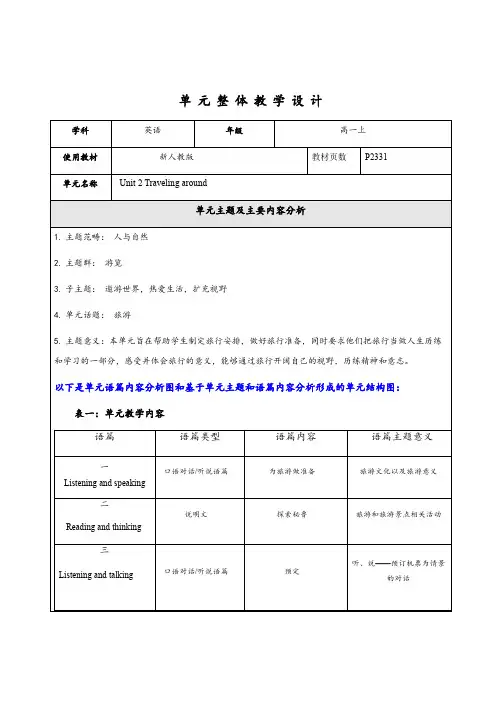
单元整体教学设计四Reading for writing 书信、说明书旅游假话、兵马俑介绍读、写——以电子邮为方式的旅游计划的输入和输出五Discovering Useful Structures 对话讨论将来的活动以旅游计划为主要语境,学会正确使用现在进行时结构表达将来的活动;表二:单元大观念主题大观念小观念1:初步介绍旅游的点,方式,交通工具以及个人对景点的简单评价。
构建旅游相关小观念2: 了解秘鲁的旅游资源,开阔视野小观念3:介绍自己的旅行计划,发现生活中的美地。
单元大观念:本单元通过了解世界各地的旅游资源等,让学生把旅行当做人生历练和学习的一部分,加深对人与自然关系的理输出:用学到的关于旅游计划的语言知识和相关要点写一篇旅游计划输出:讨论自己旅行计划,用英语分享给同学。
输出:用英语向同学介绍秘鲁旅行,和同学合作完成一个travel brochure输出:写信介绍自己的旅游计划Listening and speaking:口语对话讨论自己自己旅行计划,为旅行做准备,用英语分享给同学。
Reading and thinking: 首先百科知识介绍秘鲁的地理位置和历史文化。
杂志介绍四个它的景点。
Reading for writing:写信介绍自己的旅游计划,目的,交通工具等,阐明原因,表达期望。
核心素养的综合表现:旅行不仅可以拓宽人的视野,陶冶品性,还能够增添人生阅历,在旅行中学习。
本单元旨在帮助学生制定旅行安排,做好旅行准备,同时要求他们把旅行当做人生历练和学习的一部分,感受并体会旅行的意义,能够通过旅行开阔自己的视野,历练精神和意志。
学情分析语言大观念小观念1:围绕语义整合性学习词汇和表达方式小观念2:围绕本单元所学目标语言点,写一篇旅行计划。
谈论旅行计划,为旅行做准备描述方式语篇结构介绍秘鲁旅行词汇短语:rent, passport, visa,make travel arrangements, have a plan for the ing holiday, look forward to sth./ doing sth.句型:词汇短语:transport,contact, source,unique, admire,flight, emperor,destination, official,narrow,recognisesb. /sth. as/to be,arrange sb’sacmodation,admiresb. for sth.,make1.应用文:旅行计划2.文章以一般现在时、一般将来时为主3.用计划句型4.使用过渡词语篇结构:总分总1. The beginning(I’m writing to sharemy travel plan withyou.)2. The body(Overthe holiday, myparents and I areplanning to go to ....)3.The ending(In a。
牛津译林版八年级下册Unit 2《Travelling》教学设计3一. 教材分析《Travelling》是牛津译林版八年级下册Unit 2的一篇课文,主题是关于旅行的。
教材通过描述不同地方的自然风光、人文景观和风土人情,引导学生了解世界各地的旅游胜地,激发他们的学习兴趣。
本文主要讲述了一位游客在中国旅行时的所见所闻,介绍了中国的长城、故宫和西湖等著名景点。
二. 学情分析八年级的学生已经具备了一定的英语基础,能够理解和表达简单的日常生活和旅行相关的词汇和句子。
但他们对一些专业术语和复杂句型可能还比较陌生,因此需要在教学中给予适当的引导和帮助。
此外,学生对中国的传统文化和旅游景点有一定的了解,但可能缺乏系统的表达和描述能力。
三. 教学目标1.知识目标:学生能够掌握与旅行相关的词汇和表达方式,如“旅游胜地”、“自然风光”、“风土人情”等。
2.能力目标:学生能够听懂、说清、读懂并运用本文的主要内容,描述自己喜欢的旅游胜地。
3.情感目标:通过学习本文,学生能够增强对祖国美好河山的热爱之情,激发他们学习英语的兴趣。
四. 教学重难点1.重点:学生能够理解和运用与旅行相关的词汇和表达方式。
2.难点:学生能够听懂、说清、读懂并运用本文的主要内容,描述自己喜欢的旅游胜地。
五. 教学方法1.情境教学法:通过设定旅行情境,引导学生参与课堂活动,提高他们的学习兴趣。
2.交际教学法:利用小组讨论、角色扮演等形式,让学生在实际语境中运用英语进行交流。
3.任务型教学法:通过完成各种任务,培养学生解决问题的能力,提高他们的英语综合运用能力。
六. 教学准备1.教师准备:提前准备好与旅行相关的图片、视频等教学资源,制作多媒体课件。
2.学生准备:预习课文,了解课文内容,准备课堂讨论。
七. 教学过程1.导入(5分钟)利用图片或视频展示中国的旅游景点,如长城、故宫、西湖等,引导学生谈论他们所了解的旅游胜地。
教师提问:“Do you like travelling? Why?”,激发学生的学习兴趣。